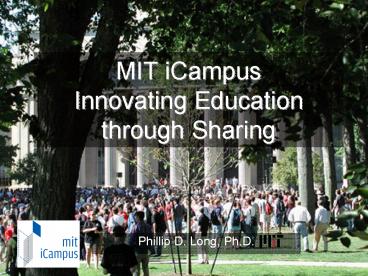MIT iCampus Innovating Education through Sharing - PowerPoint PPT Presentation
1 / 29
Title: MIT iCampus Innovating Education through Sharing
1
MIT iCampusInnovating Education through Sharing
- Phillip D. Long, Ph.D.
2
Sharing educationalinnovation
- OpenCourseWare makes all MIT course content free
to everyone - OCW is a pure publication model No significant
interaction with MIT faculty - Effective sharing of technology requires deeper
interaction - MIT iCampus complements OpenCourseWare by sharing
- technology,
- tools, as well as
- providing implementation assistance for these new
pedagogies
3
- iCampus is an MIT research program to enhance
university education through information
technology - Established in 1999 with funding from Microsoft
Research - 2000 2004 Focus on impact at MIT
- Sponsored projects involving over 400 MIT
faculty, staff, and researchers - Has affected nearly 100 subjects with a combined
enrollment of over 5,000 students per year - 2004-2006 Focus on global dissemination
4
MIT iCampus Affiliates
- Beginning 2005
- Hub and spoke model for dissemination
- Affiliates get access to iCampus materials and
support via hub institutions - Hubs work closely with MIT in development,
support, and dissemination
5
Six initial projects
- iCampus is initially preparing six projects for
dissemination - Remote access to laboratory equipment
- On-line lectures and exercises in computer
science - Visualizations in electromagnetism
- Collaborative design in mechanical engineering
- Web-administered writing examinations
- Domain specific gesture recognition in Tablet PCs
6
iLabs Worldwide shared access to laboratory
equipment
- Remote access to one or two MIT labs
- Toolkit for creating and sharing your own labs
Innovating education, sharing technology
7
Uniqueness of iLabs
- Pedagogy
- iLabs create laboratory experiences in subjects
that didnt have them before. - iLabs enable laboratory experiments at most
opportune moment in curriculum. - iLabs allow students to perform experiments in
pleasant environments at times of their choice - iLabs minimize frustrations with hardware
Innovating education, sharing technology
8
Uniqueness of iLabs
- Logistics
- iLabs can be located in places inaccessible to
students - iLabs hold unique scaling characteristics
- round the clock usage
- from anywhere in the world
- Economics
- iLabs can be broadly shared ? fundamental change
in economics of the lab experience
Innovating education, sharing technology
9
Revolutionary consequences
- Order-of-magnitude more laboratory experiences
available to students - Can afford sophisticated labs involving
- advanced instrumentation
- rare materials
- unreachable locations
- iLabs embedded inside rich educational platforms
containing - visualization tools, simulations, data processing
- remote collaboration and tutoring.
Innovating education, sharing technology
10
Revolutionary consequences
- iLabs will spawn communities of learners to
share - hardware
- educational content
- Institutions around the world can support
educational needs of each other.
Innovating education, sharing technology
11
Microelectronics lab hardware
Semiconductor Parameter Analyzer, Switching Matrix
Device under test
Device test fixtures
server
12
Web-Based LaboratoryMicroelectronics
Characterization Lab
- Lab can be accessed from anywhere at anytime
- Single set-up leveraged among many users
- Minimum staffing requirements
- Minimum training
- No user safety concerns
Innovating education, sharing technology
13
Local Service Broker
Lab Servers
Clients
Local databases
iLabs Shared Architecture
Campus service broker
Campus network
Internet
Clients
Local labs
Lab equipment and servers
Local databases
Innovating education, sharing technology
14
Batched Experiment Network Topology
- In the batched experiment architecture, the
client and the lab server communicate only
through the Service Broker
No Direct Communication
X
Interactive Experiment
Innovating education, sharing technology
15
Preliminary Interactive Topology
Labside Campus
Clientside Campus
Innovating education, sharing technology
16
iLabs _at_ MIT
Place holder for picture from Kent
Dynamic signal analyzer (EECS, to be deployed
2004)
Shake table (Civil Eng., to be deployed 2004)
Polymer crystallization (Chem. E., deployed 2003)
Microelectronics device characterization (EECS,
deployed 1998)
Heat exchanger (Chem. E., deployed 2001)
17
Microelectronics web-based laboratory
- Used at MIT since 1998.
- Also used for classes in Singapore, Sweden,
England, Greece - Lab project materials available on OCW
Try it out at http//openilabs.mit.edu
18
Weblab Microelectronics Experiment User Interface
19
iLabs Workshops
- iLabs implementation and development workshops
are supported by iCampus through hub affiliates - The first iLabs software workshop presentation
materials are available at - http//stellar.mit.edu/S/project/ilabs
Innovating education, sharing technology
20
How you can use iLabs with iCampus and OCW
http//icampus.mit.edu/ilabs
21
MIT Online Assessment Tool
Test students like this
Not like this
iMOAT
- Web-based service for administering writing
examinations - Used for MIT writing placement exams for entering
students since 1998 - Enables academic institutions to collaborate in
administering and evaluating online essay
examinations
Innovating education, sharing technology
22
Why iMOAT?
- Existing modes of assessment inadequate
- Timed impromptu
- Portfolio
- Increasing demands for reliable and valid writing
assessments - Students write on computers not paper
- Need for standard system on standard platform
Innovating education, sharing technology
23
The Common Practice
- Student walks into large room and writes with pen
and paper on small desk - Student reads, at most, a two or three paragraph
text for each essay - Student writes one or two essays on specific
questions - Handwritten essays are graded (usually by two
readers) - Results are sent on paper to student and / or
advisor
Innovating education, sharing technology
24
A student logs into thesystem for the first time
iMOAT
Innovating education, sharing technology
25
Essays are graded with comments
Innovating education, sharing technology
26
Test Students
This Way
Not This Way
- Allows student to know placement decision well in
advance - Student is less stressed during orientation
- Writing tasks are more interesting
Innovating education, sharing technology
27
iMOAT built for writing assessment
- Its fundamentally workflow engine
- Where else might it be useful?
Innovating education, sharing technology
28
Writing assessment Materials with iCampus
http//icampus.mit.edu/imoat
29
Thank You
- Phillip D. Long longpd_at_mit.edu
Innovating education, sharing technology































